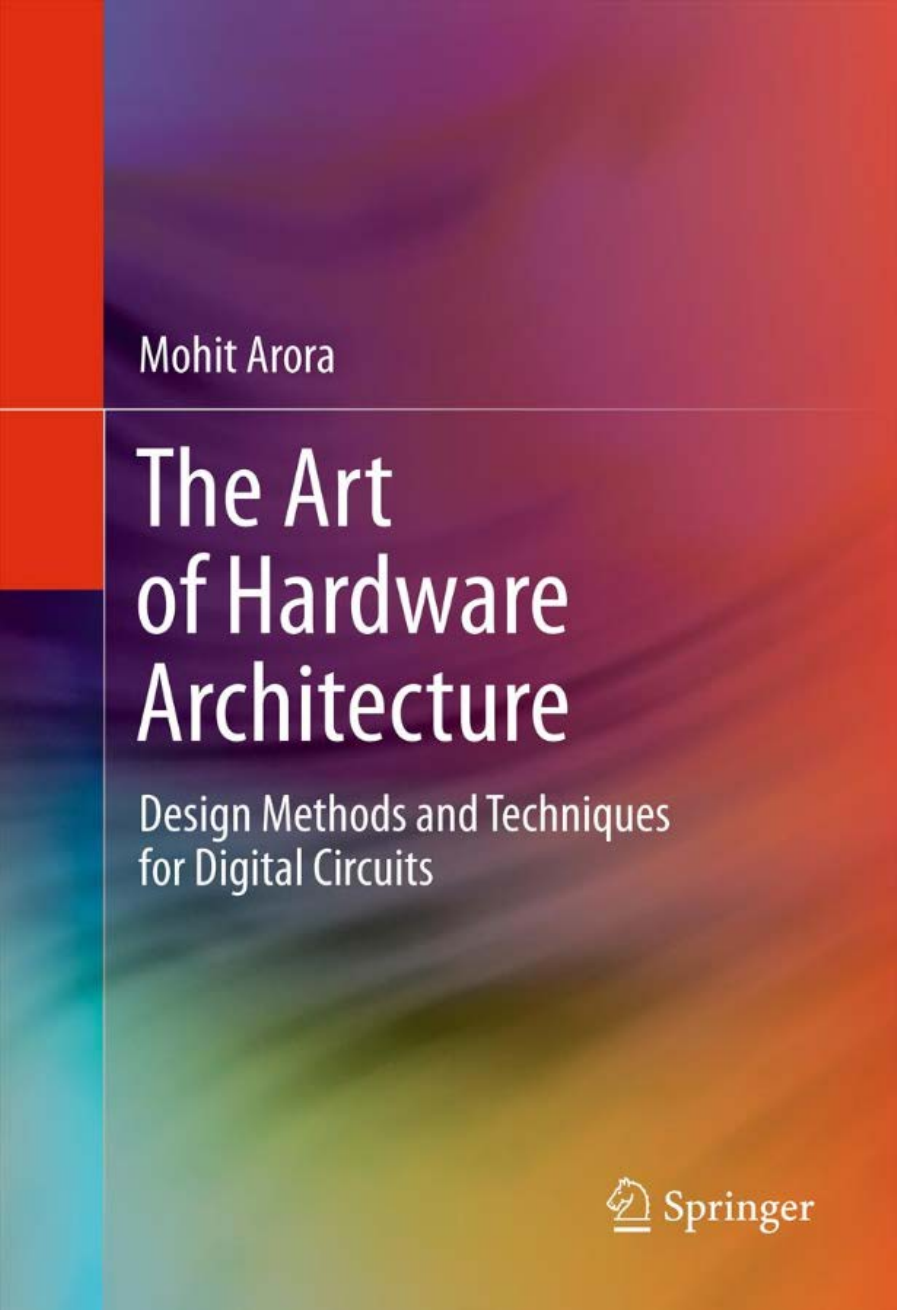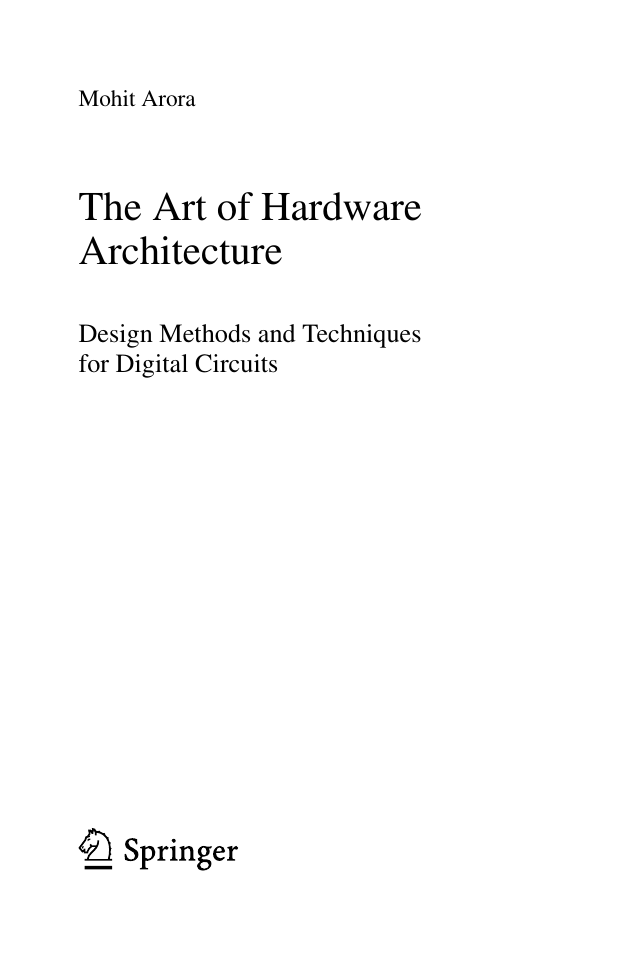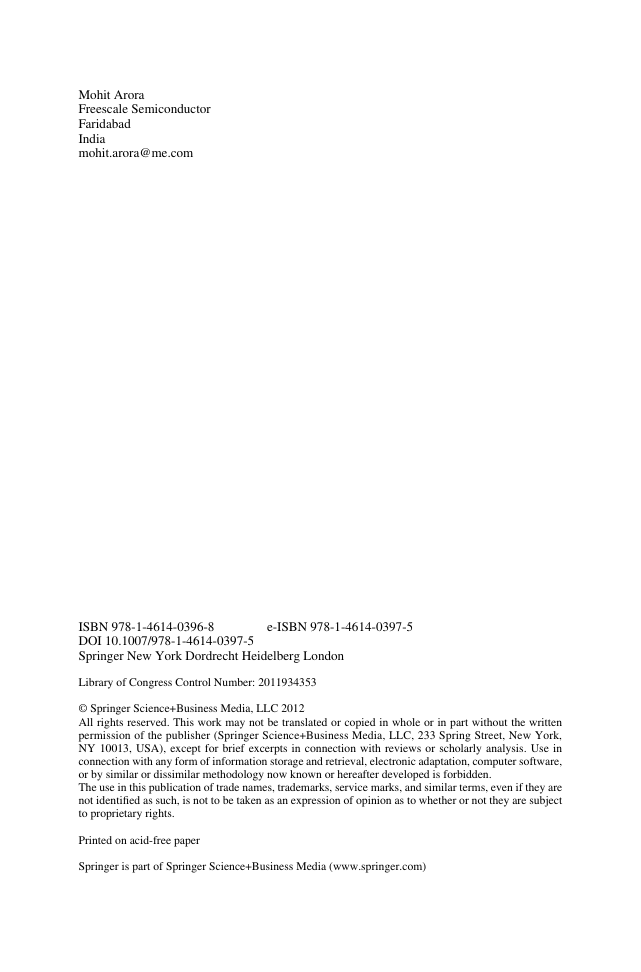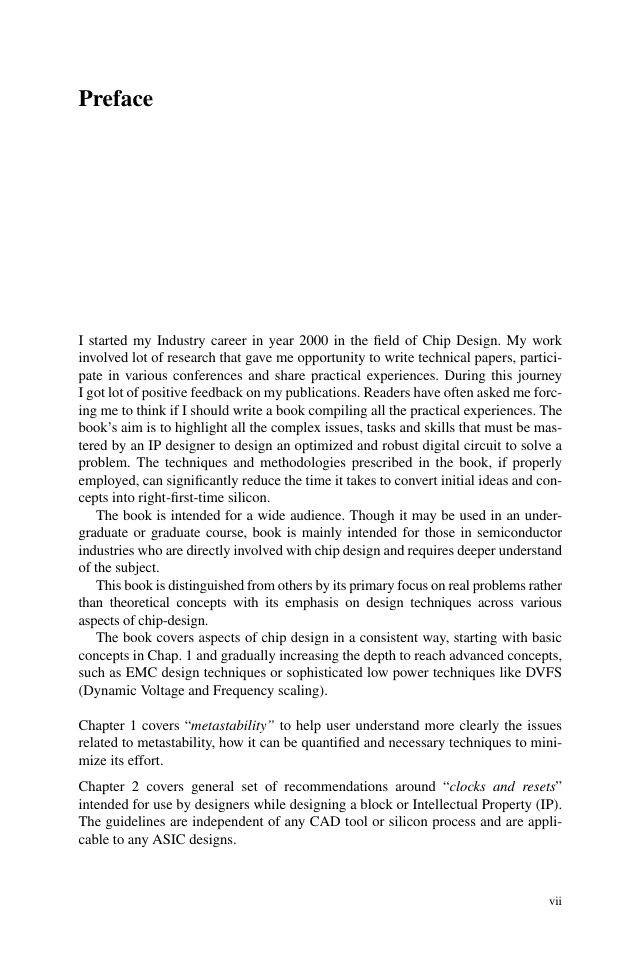Cover
The Art of Hardware Architecture
ISBN 9781461403968
Preface
Acknowledgements
Contents
Chapter 1: The World of Metastability
1.1 Introduction
1.2 Theory of Metastability
1.3 Metastability Window
1.4 Calculating MTBF
1.5 Avoiding Metastability
1.5.1 Using a Multi-stage Synchronizer
1.5.2 Multi-stage Synchronizer Using Clock Boost Circuitry
1.6 Metastability Test Circuitry
1.7 Types of Synchronizers
1.8 Metastability/General Recommendations
Chapter 2: Clocks and Resets
2.1 Introduction
2.2 Synchronous Designs
2.2.1 Avoid Using Ripple Counters
2.2.2 Gated Clocks
2.2.3 Double-Edged or Mixed Edge Clocking
2.2.4 Flip Flops Driving Asynchronous Reset of Another Flop
2.3 Recommended Design Techniques
2.3.1 Avoid Combinational Loops in Design
2.3.2 Avoid Delay Chains in Digital Logic
2.3.3 Avoid Using Asynchronous Based Pulse Generator
2.3.4 Avoid Using Latches
2.3.5 Avoid Using Double-Edged Clocking
2.3.5.1 Advantages of Dual Edge Clocking
2.4 Clocking Schemes
2.4.1 Internally Generated Clocks
2.4.2 Divided Clocks
2.4.3 Ripple Counters
2.4.4 Multiplexed Clocks
2.4.5 Synchronous Clock Enables and Gated Clocks
2.5 Clock Gating Methodology
2.5.1 Latch Free Clock Gating Circuit
2.5.2 Latch Based Clock Gating Circuit
2.5.3 Gating Signals
2.5.4 Data Path Re-ordering to Reduce Switching Propagation
2.6 Reset Design Strategy
2.6.1 Design with Synchronous Reset
2.6.1.1 Advantages of Using Synchronous Resets
2.6.1.2 Disadvantages of Using Synchronous Resets
2.6.2 Design with Asynchronous Reset
2.6.2.1 Advantages of Using Asynchronous Resets
2.6.2.2 Disadvantages of Using Asynchronous Resets
2.6.3 Flip Flops with Asynchronous Reset and Asynchronous Set
2.6.4 Asynchronous Reset Removal Problem
2.6.5 Reset Synchronizer
2.6.6 Reset Glitch Filtering
2.7 Controlling Clock Skew
2.7.1 Short Path Problem
2.7.2 Clock Skew and Short Path Analysis
2.7.3 Minimizing Clock Skew
2.7.3.1 Adding Delay in Data Path
2.7.3.2 Clock Reversing
2.7.3.3 Alternate Phase Clocking
Clocking on Alternate Edges
Clocking on Alternate Phases
Ripple Clocking Structure
2.7.3.4 Balancing Trace Length
References
Chapter 3: Handling Multiple Clocks
3.1 Introduction
3.2 Multiple Clock Domains
3.3 Problems with Multiple Clock Domains Design
3.3.1 Setup Time and Hold Time Violation
3.3.2 Metastability
3.4 Design Tips for Efficient Handling of a Design with Multiple Clocks
3.4.1 Clock Nomenclature
3.4.2 Design Partitioning
3.4.3 Clock Domain Crossing
3.4.3.1 Transfer of Control Signals (Synchronization)
3.4.3.2 Transfer of Data Signals
3.5 Synchronous Clock Domain Crossing
3.5.1 Clocks with the Same Frequency and Zero Phase Difference
3.5.2 Clocks with the Same Frequency and Constant Phase Difference
3.5.3 Clocks with the Different Frequency and Variable Phase Difference
3.5.3.1 Clocks with Integral Multiple Frequencies
3.5.3.2 Clocks with Non-integral Multiple Frequencies
3.6 Handshake Signaling Method
3.6.1 Requirements for Handshake Signaling
3.6.2 Disadvantages of Handshake Signaling
3.7 Data Transfer Using Synchronous FIFO
3.7.1 Synchronous FIFO Architecture
3.7.2 Working of Synchronous FIFO
3.7.2.1 FIFO Full and Empty Generation
3.7.2.2 An Alternative Approach
3.8 Asynchronous FIFO (or Dual Clock FIFO)
3.8.1 Avoid Using Binary Counters for the Pointer Implementation
3.8.2 Use Gray Coding Instead of Binary for the Counters
3.8.2.1 Effect of Synchronization of Pointers
3.8.3 Gray Code Implementation of FIFO Pointers
3.8.3.1 Gray to Binary Converter
3.8.3.2 Binary to Gray Converter
3.8.3.3 Gray code counter implementation
3.8.4 FIFO Full and FIFO Empty Generation
3.8.4.1 An Alternative approach for FIFO Full and FIFO Empty Generation
3.8.5 Dual Clock FIFO Design
3.8.5.1 FIFO Empty Condition Generation
3.8.5.2 FIFO Full Condition Generation
References
Chapter 4: Clock Dividers
4.1 Introduction
4.2 Synchronous Divide by Integer Value
4.3 Odd Integer Division with 50% Duty Cycle
4.4 Non-integer Division (with a Non 50% Duty Cycle)
4.4.1 Divide by 1.5 with Non 50% Duty Cycle
4.4.2 Counter Implementation for Divide by 4.5 (Non 50% Duty Cycle)
4.5 Alternate Approach for Divide by N
4.5.1 LUT Implementation for Divide by 1.5
Reference
Chapter 5: Low Power Design
5.1 Introduction
5.2 Sources of Power Consumption
5.3 Power Reduction at Different Levels of Design Abstraction
5.4 System Level Power Reduction
5.4.1 System on Chip (SoC) Approach
5.4.2 Hardware/Software Partitioning
5.4.3 Low Power Software
5.4.4 Choice of Processor
5.5 Architecture Level Power Reduction
5.5.1 Advanced Clock Gating
5.5.2 Dynamic Voltage and Frequency Scaling (DVFS)
5.5.3 Cache Based Architecture
5.5.4 Log FFT Architecture
5.5.5 Asynchronous (Clockless) Design
5.5.6 Power Gating
5.5.6.1 Fine-Grain Power Gating
5.5.6.2 Coarse Grain Power Gating
5.5.7 Multi-threshold Voltage
5.5.8 Multi-supply Voltage
5.5.9 Gate Memory Power
5.6 Register Transfer Level (RTL) Power Reduction
5.6.1 State Machine Encoding and Decomposition
5.6.2 Binary Number Representation
5.6.3 Basic Gated Clock
5.6.4 One Hot Encoded Multiplexer
5.6.5 Removing Redundant Transactions
5.6.6 Resource Sharing
5.6.7 Using Ripple Counters for Low Power
5.6.8 Bus Inversion
5.6.9 High Activity Nets
5.6.10 Enabling-Disabling Logic Clouds
5.7 Transistor Level Power Reduction
5.7.1 Technology Level
5.7.2 Layout Optimization
5.7.3 Substrate Biasing
5.7.4 Reduce Oxide Thickness
5.7.5 Multi-oxide Devices
5.7.6 Minimizing Capacitance by Custom Design
References
Chapter 6: The Art of Pipelining
6.1 Introduction
6.2 Factors Affecting the Maximum Frequency of Clock
6.2.1 Clock Skew
6.2.2 Clock Jitter
6.3 Pipelining
6.4 Pipelining Explained – A Real Life Example
6.5 Performance Increase from Pipelining
6.6 Implementation of DLX Instruction
6.7 Effect of Pipelining on Throughput
6.8 Pipelining Principles
6.9 Pipelining Hazards
6.9.1 Structural Hazards
6.9.2 Data Hazards
6.9.3 Control Hazards
6.9.4 Other Hazards
6.10 Pipelining in ADC – An Example
References
Chapter 7: Handling Endianness
7.1 Introduction
7.2 Definition
7.3 Little-Endian or Big-Endian: Which Is Better?
7.4 Issues Dealing with Endianess Mismatch
7.5 Accessing 32 Bit Memory
7.6 Dealing with Endianness Mismatch
7.6.1 Preserve Data Integrity (Data Invariance)
7.6.1.1 Data Flow
7.6.2 Address Invariance
7.6.2.1 Data Flow
7.6.3 Software Byte Swapping
7.6.3.1 Methods
Swap Assembly Instructions
Swap Library Macros
Protocol Specific Macros
Limitation
7.7 Endian Neutral code
7.8 Endian-Neutral Coding Guidelines
References
Chapter 8: Deboucing Techniques
8.1 Introduction
8.2 Behavior of a Switch
8.3 Switch Types
8.4 De-bouncing Techniques
8.4.1 RC De-bouncer
8.4.2 Hardware De-bouncers
8.4.3 Software De-bouncing
8.4.4 De-bouncing Guidelines
8.4.5 De-bouncing on Multiple Inputs
8.5 Existing Solutions
Chapter 9: Design Guidelines for EMC Performance
9.1 Introduction
9.2 Definition
9.3 EMI Theory and Relationship with Current and Frequency
9.4 EMI Regulations, Standards and Certification
9.5 Factors Affecting IC Immunity Performance
9.5.1 Microcontroller as Noise Source
9.5.2 Other Factors Affecting EMC
9.5.3 Noise Carriers
9.6 Techniques to Reduce EMC/EMI
9.6.1 System Level Techniques
9.6.1.1 Spread Spectrum Clocking
9.6.1.2 Differential Clocking
9.6.2 Board Level Techniques
9.6.2.1 Power Entry Filtering
9.6.2.2 More Filtering
EMI Filters
9.6.2.3 Component Placement
9.6.2.4 Path to Ground
9.6.2.5 Trace Routing
9.6.2.6 Creating Zones
9.6.2.7 Power Coupling
9.6.2.8 PCB Power Distribution and Decoupling Capacitors
9.6.3 Microcontroller Level Techniques
9.6.3.1 Multiple Clocks and Grounds
9.6.3.2 Eliminate Race Conditions
9.6.3.3 Reduce System Speed
9.6.3.4 Driver Sizing
9.6.3.5 Clock Generation and Distribution
9.6.3.6 Duty Cycle Consideration
9.6.3.7 Reducing Noise on Data Buses
9.6.4 Software Level Techniques
9.6.4.1 General I/O Pin Protection
9.6.4.2 Digital Input Pins
9.6.4.3 Digital Output and Critical Registers
9.6.4.4 Reset Pin Protection
9.6.4.5 Oscillator and Other Sensitive Pins
9.6.4.6 Watchdog Timer
9.6.4.7 Illegal Instruction and Illegal Address Resets
9.6.4.8 Low Voltage Detect (LVD)/Low Voltage Warning (LVW)
9.6.5 Other Techniques
9.6.5.1 Multiple Power and Grounds Pins
9.6.5.2 Use Slowest Technology
9.7 Summary
References
References
Index
















 2023年江西萍乡中考道德与法治真题及答案.doc
2023年江西萍乡中考道德与法治真题及答案.doc 2012年重庆南川中考生物真题及答案.doc
2012年重庆南川中考生物真题及答案.doc 2013年江西师范大学地理学综合及文艺理论基础考研真题.doc
2013年江西师范大学地理学综合及文艺理论基础考研真题.doc 2020年四川甘孜小升初语文真题及答案I卷.doc
2020年四川甘孜小升初语文真题及答案I卷.doc 2020年注册岩土工程师专业基础考试真题及答案.doc
2020年注册岩土工程师专业基础考试真题及答案.doc 2023-2024学年福建省厦门市九年级上学期数学月考试题及答案.doc
2023-2024学年福建省厦门市九年级上学期数学月考试题及答案.doc 2021-2022学年辽宁省沈阳市大东区九年级上学期语文期末试题及答案.doc
2021-2022学年辽宁省沈阳市大东区九年级上学期语文期末试题及答案.doc 2022-2023学年北京东城区初三第一学期物理期末试卷及答案.doc
2022-2023学年北京东城区初三第一学期物理期末试卷及答案.doc 2018上半年江西教师资格初中地理学科知识与教学能力真题及答案.doc
2018上半年江西教师资格初中地理学科知识与教学能力真题及答案.doc 2012年河北国家公务员申论考试真题及答案-省级.doc
2012年河北国家公务员申论考试真题及答案-省级.doc 2020-2021学年江苏省扬州市江都区邵樊片九年级上学期数学第一次质量检测试题及答案.doc
2020-2021学年江苏省扬州市江都区邵樊片九年级上学期数学第一次质量检测试题及答案.doc 2022下半年黑龙江教师资格证中学综合素质真题及答案.doc
2022下半年黑龙江教师资格证中学综合素质真题及答案.doc